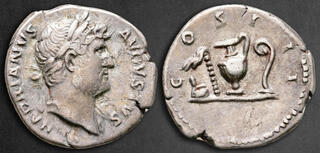| Savoca Numismatik GmbH & Co. KG > Online Auction 209 | Silver | Auction date: 28 April 2024 |
| Lot number: 411 Price realized: 90 EUR (Approx. 96 USD) Note: Prices do not include buyer's fees. | Show similar lots on CoinArchives Find similar lots in upcoming auctions on |
| Lot description: Hadrian AD 117-138. Rome Denarius AR 18 mm, 3,20 g HADRIANVS AVGVSTVS, laureate bust right, slight drapery on left shoulder / COS III, priestly implements: simpulum, apergillum, jug and lituus. Very Fine RIC II.3 801; BMC 453. In ancient Roman religious ceremonies, several objects held significant roles in facilitating rituals and offerings to the gods. Among these were the simpulum, apergillum, jug, and lituus. The simpulum, resembling a ladle or spoon, was instrumental in pouring wine or other libations during sacrifices. Its design allowed priests to transfer liquids from larger vessels to smaller ones or distribute them among participants in the ritual. The apergillum, a type of ritual sprinkler or brush, served to sprinkle holy water during ceremonies, symbolizing purification. Priests would dip it into water and sprinkle it over objects or individuals to sanctify them. Jugs, made of clay or metal, were used to contain and pour wine, water, or other libations offered to the gods. Their size and design varied based on the specific ritual or the status of the individual performing the sacrifice. The lituus, a curved wand or staff, was wielded by priests and augurs for divination and ritual purposes. Its curved shape resembled a shepherd's crook and was utilized to mark sacred spaces or trace patterns in the sky during bird observations for omens.These objects were indispensable in ancient Roman religious practices, aiding priests in conducting ceremonies, offering sacrifices, and communicating with the gods. Their presence ensured the adherence to traditional religious customs and the proper execution of sacred rituals in Roman society. Starting price: 50 EUR |  |


